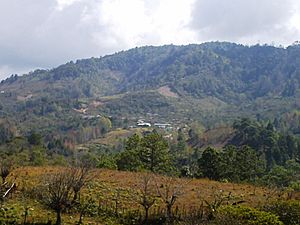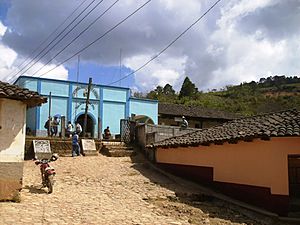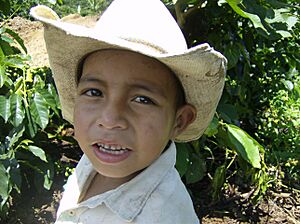San Andrés, Honduras facts for kids
San Andrés is a town and a local government area (called a municipality) in the Lempira department of Honduras.
It is famous in Honduras for its opal mines. Opals are beautiful gemstones. These opals come from a place called Las Colinas, near a village named Social. Most of the mining here is done by small groups of miners, not big companies.
San Andrés is about 120 kilometers (75 miles) from Gracias city. It is also about an hour's drive from Erandique city.
Contents
History of San Andrés
San Andrés has a long history. In a count of people from 1801, it was known as the "Guaxinlaca" village. It was part of a larger area called "Gracias a Dios." Later, in 1889, when Honduras divided its land into different areas, San Andrés became a municipality in the Erandique district.
Exploring San Andrés' Geography
San Andrés is located high up in the mountains. Because of this, you will find many pine and oak trees in its forests. The high elevation is also perfect for growing coffee plants. The mountains and hills around San Andrés are very tall and steep. Many small rivers and water springs flow down these hills.
One cool thing to see is a huge rock called a monolith. It's on the way to the main city of the department. This giant rock shows that the area, including San Andrés, was formed by volcanoes a long time ago!
Where is San Andrés?
San Andrés shares its borders with several other towns and municipalities:
- To the North: La Campa, San Sebastián, and Santa Cruz municipalities.
- To the South: Gualcince municipality.
- To the East: Erandique municipality.
- To the West: Valladolid, Tambla, and Tomalá municipalities.
The total area of San Andrés is 243 square kilometers (about 94 square miles).
What San Andrés Produces
The most important product grown in San Andrés is coffee. The high mountains and good soil make it a great place for coffee plants to grow. People also grow vegetables, corn, and beans. Raising cattle and making milk products are also important, but these are mostly for people living in San Andrés.
The forests are used carefully, so they don't get damaged. San Andrés has electricity, but sometimes it can go out for a few days. Mobile phone services are available. Some people even sell gasoline and diesel fuel from their homes.
People of San Andrés
Most people in San Andrés are descendants of the original Indigenous people of the area, especially in the villages around the main town. The rest of the population is a mix of Spanish and Indigenous heritage.
- Population Count: In 2001, about 10,472 people lived in San Andrés. By 2015, it was estimated that the population grew to about 13,585 people.
- Villages: There are 8 main villages in the municipality.
- Smaller Settlements: There are 144 smaller communities or settlements.
Who Lives in San Andrés?
A census in 2013 showed that out of 13,151 people in San Andrés:
- About 52.5% were Indigenous, mostly from the Lenca group.
- About 47.2% were Mestizo (a mix of European and Indigenous heritage).
- A small number (0.27%) were Black or Afro-Honduran.
- A very small number (0.04%) were White.
Visiting San Andrés
To get to San Andrés, you usually turn off the main road at a spot called "El Guayabo." From there, it's about a 15-minute drive to the main town. Some parts of the road are narrow, only wide enough for one car, and can be slippery.
When you visit, you can enjoy the beautiful forests, especially the "Liquidambar" forest. These trees are special because their leaves change colors with the seasons, just like in some parts of North America!
There are no hotels or places to stay right in San Andrés. However, since it's close to Erandique, you can find places to stay there.
A special day in San Andrés is "San Andrés Day," celebrated on November 30th.
See also
 In Spanish: San Andrés (Honduras) para niños
In Spanish: San Andrés (Honduras) para niños






